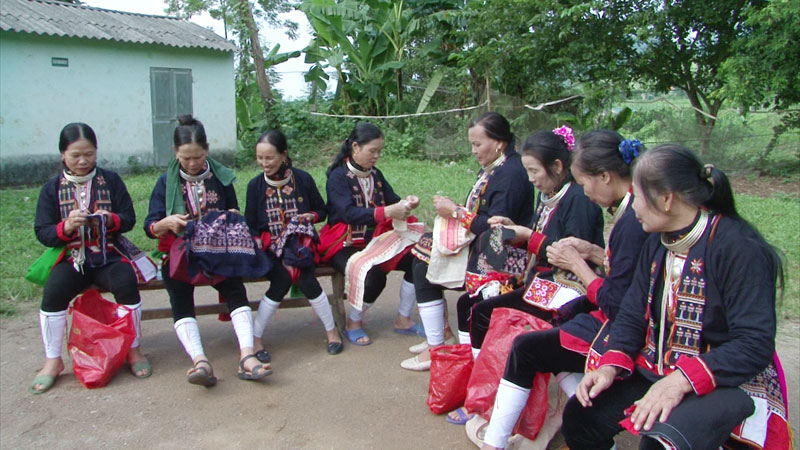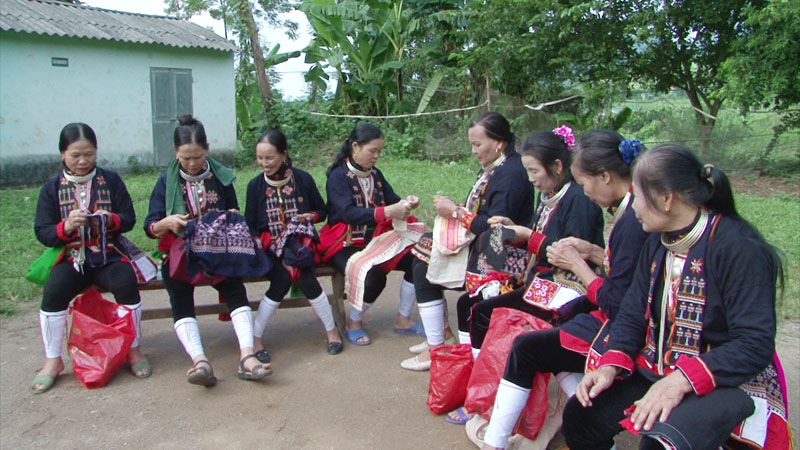
(HBO) – Hoa Binh province is home to two Dao ethnic minority groups, namely Dao quan chet and Dao tien, who mainly live in Da Bac, Kim Boi, Cao Phong, Mai Chau, Ky Son and Luong Son districts, and Hoa Binh city.

Clothes
of the Dao groups are decorated with unique patterns on the background of
indigo colour, with a harmonious combination of accessories like scarves and
jewelries. Dao quan chet women boast a special dressing style as their trousers
are tightened to their legs.
Ban
Sinh Luong, a prestigious elderly in the Dao quan chet community in Dong Chua
hamlet, Thong Nhat commune, Hoa Binh city, said Dao people still wear their
traditional costume during the Tet festival, weddings and funerals.
Apart
from shirts and pants, Dao women also put on other accessories such as
brassieres, headscarves, silver necklaces and belts.
It
is noteworthy that Dao quan chet people do not practise weaving and they have
to buy fabric to make clothes. However, they weave belts themselves and embroider
them with colourful patterns. The art of fabric decoration has been preserved
among the community, and girls have to learn these skills from their mothers,
grandmothers, other family members and villagers at a fixed age.
Dao
quan chet women do not wear skirts but pants (Hau) that are made of indigo
fabric ending below knees and tightened to legs. Pant cuffs are decorated with
patterns and edges are stitched with colourful threads.
Of
note, Dao quan chet women wrap their calves with xa cap (chay keo) made of
white fabric clockwise.
Another
important accessory of Dao quan chet women is the scarf (called Coong pe song
in local language), made of three layers of black fabric whose ends are decorated
with floral patterns, eight-pointed stars and "Longevity” letter.
Unlike
women, Dao men’s costume is simple, comprising shirts (chang lui), trousers
(chang hau) and scarves (goong xong) of indigo or black colours.
To
preserve the traditional costume and culture, the provincial People’s Committee
has devised a project on building a centre protecting culture of the Dao quan
chet ethnic minority group in Thong Nhat commune in service of community-based
tourism. The project has also helped locals raise their income and living
standards./.
With an increasingly vibrant and widespread emulation movement aimed at building cultured residential areas and cultured families, Yen Thuy District has been making steady progress toward improving both the material and spiritual well-being of its people, while fostering a civilized, prosperous, beautiful, and progressive community.
Once lacking recreational spaces and community facilities, Residential Group 2 in Quynh Lam Ward (Hoa Binh City) has recently received attention for the construction of a new, spacious, and fully equipped cultural house. The project followed the model of state support combined with public contributions in both labor and funding.
The "All people unite to build cultural life" movement, which has been effectively integrated with Kim Boi district’s socio-economic development goals, is fostering a lively spirit of emulation across local residential areas, hamlets, villages, public agencies, and enterprises. In addition, through the initiative, traditional cultural values are being preserved and promoted, while community solidarity and mutual support in poverty reduction and economic development are being strengthened.
A working delegation of the Hoa Binh provincial People’s Committee led by its Permanent Vice Chairman Nguyen Van Toan on June 11 inspected the progress of a project to build the Mo Muong Cultural Heritage Conservation Space linked to tourism services in Hop Phong commune, Cao Phong district.
Born and growing in the heroic land of Muong Dong, Dinh Thi Kieu Dung, a resident in Bo town of Kim Boi district, in her childhood was nurtured by the sweet lullabies of her grandmother and mother. These melodies deeply imprinted on her soul, becoming an inseparable part of her love for her ethnic group's culture. For over 20 years, this love for her hometown has driven Dung to research, collect, and pass down the cultural values of the Muong people to future generations.
In the final days of May, the Ethnic Art Troupe of Hoa Binh Province organized performances to serve the people in remote, mountainous, and particularly disadvantaged areas within the province. These were not just ordinary artistic shows, but they were the meaningful journeys aimed at spreading cultural values, enhancing the spiritual life of the people and contributing to the preservation of ethnic minority cultural identities.



